Day 202: July 21, 2018
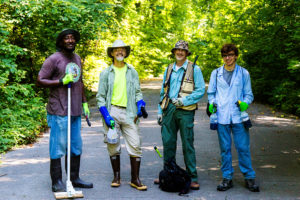
One of the major challenges of managing an old-growth forest in the heart of a city is the large number of non-native, invasive plants that find their way into the soil. Of the more than 350 species of trees, vines, and wildflowers found in the Old Forest, nearly 100 are not native to our area. Sixteen of those are considered invasive, which means they multiply quickly and crowd out the native plants that would ordinarily thrive in this part of the country.
Since assuming management of the park in 2012, Overton Park Conservancy has worked with our partners at the Tennessee Department of Environment and Conservation (TDEC) to prioritize removal of the most aggressive invasive plants. In 2012 and 2013, we removed more than 2,000 cubic yards of Chinese privet, a shrub commonly planted in residential areas to provide a privacy hedge. Those seeds came to the park via birds, mammals, and wind.
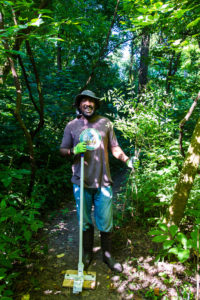
We’ve also targeted English ivy and the shrubs mahonia and nandina. Kudzu is present at low levels in the Old Forest, but our Director of Operations, Eric Bridges, stays vigilant about searching for it and treating whatever he finds before it has a chance to establish itself. Our current focus is on Chinese wisteria vine and tree of heaven, a fast-growing invasive that can establish quickly in even inhospitable conditions. (It’s the title character of A Tree Grows in Brooklyn: “the only tree that grows out of cement.”) Tree of heaven contains a toxic compound in its roots, bark, and leaves that inhibits the growth of other plants, making it particularly damaging in a fragile ecosystem like the Old Forest.
Our operations staff and volunteers tackle invasive plants through four primary methods. On Saturday, July 21, we followed Eric, our Visitor Services Coordinator Andrew Weda, volunteer Bill Bullock, and CBU summer intern Collin Dice on an invasive roundup (pun fully intended).
Method 1: The Weed Wrench
This is a tool that’s great for quickly removing woody plants like Chinese holly, nandina, and mahonia. To use it, Andrew places the stem of the plant between the jaws of the weed wrench, applies pressure with his foot, and levers the tool until the plant comes up, roots and all.
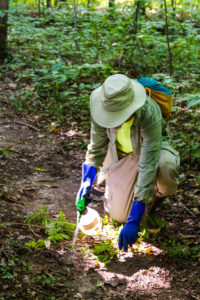
Method 2: Foliar Herbicide
For vines like Chinese wisteria that are deeply rooted underground, applying a chemical called glyphosate (the active ingredient in Round Up) directly to the leaves and allowing it to translocate through the entire plant can be effective. After spotting a wisteria leaf, Eric locates the vine and pulls it out to the trail, taking care not to break the vine. He sprays the leaves with herbicide and then returns the vine to its place, leaving the glyphosate to travel through the plant and inhibit its energy production. He also uses this method to treat kudzu, applying the selective herbicide Transline, which only affects plants in the pea family.
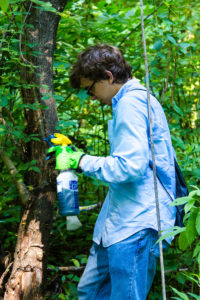
Method 3: Hack and Squirt
This method involves carefully applying chemicals to larger woody-stemmed plants. Here, Collin makes small cuts in a tree of heaven and sprays the wounds with herbicide, which will travel throughout the tree. It keeps the herbicide well-contained to the target plant, and because it travels to the roots, it tends to prevent re-sprouts.
Method 4: Basal Bark Application
While glyphosate appears to be making a dent in the wisteria, it was no match for tree of heaven. When Eric and Bill applied it to the bark of one tree earlier this summer, the tree had generated 130 re-sprouts within a few weeks! For a tree this tenacious, they’ve begun using a more potent herbicide called Element 4, with a basal oil that allows it to penetrate the bark. Bill uses a paintbrush roller to apply to stems under five inches. Eric says that this method doesn’t trigger the tree’s defense mechanisms, and so far the tree of heaven plants have stopped leafing out and haven’t re-sprouted.
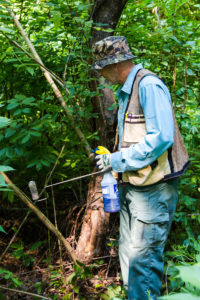
Our team will continue to monitor and treat invasive species throughout the year. It’s a never-ending job, but getting the particularly damaging species under control allows us to see positive effects almost immediately: stands of beautiful native jewelweed have quickly filled in spaces where invasives dominated as recently as last year.
It takes a significant amount of time and expertise to comb the 126 acres of the Old Forest for plants like kudzu that can hide in plain sight one day and take over entire canopy gaps within weeks. If you’d like to contribute to our forest health efforts, a gift to the Conservancy is a gift to the ecosystem!
This post is part of a series that highlights an interesting, inspiring, or important day in the life of Overton Park. Look for them near the end of each month.


